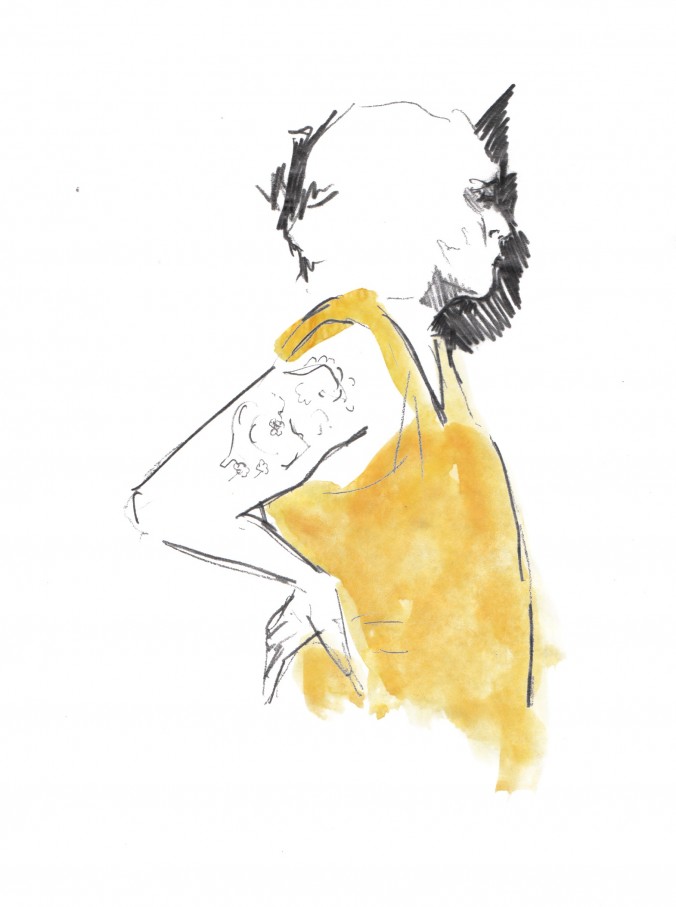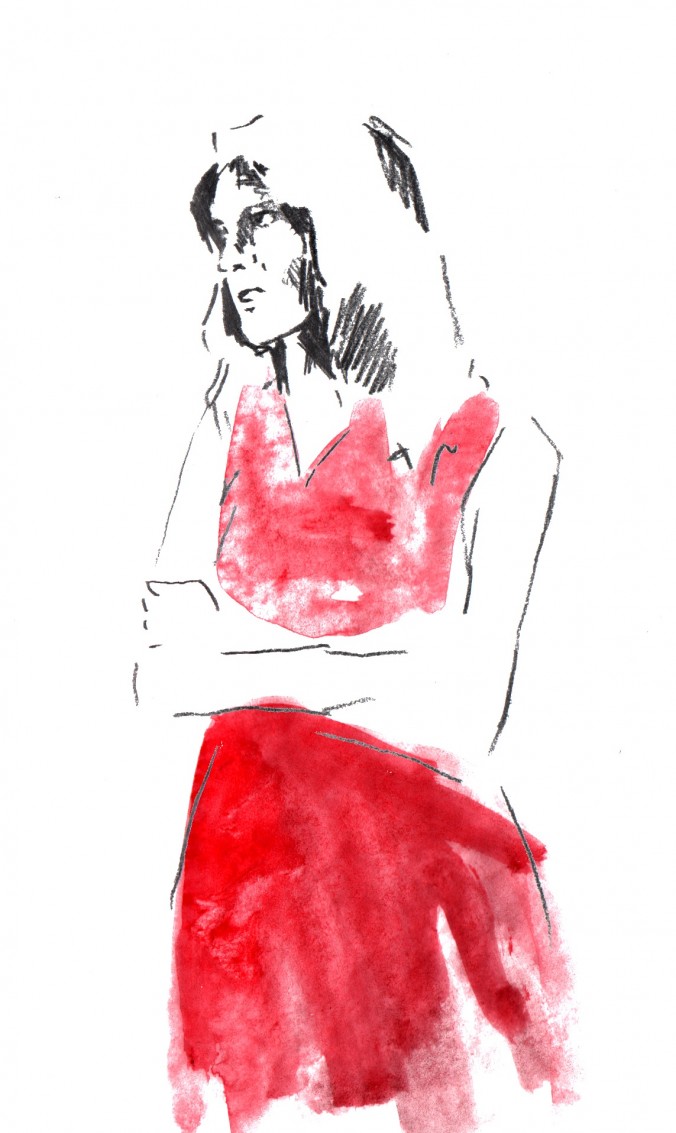Lena Dunham is the 26-year-old creator, star, writer, and ocassional director of the HBO series “Girls.” The half-hour comedy follows four twenty-somethings — Hannah (Dunham), Marnie (Allison Williams), Jessa (Jemima Kirke) and Shoshanna (Zosia Mamet) — in Brooklyn, navigating the ins and outs of Dunahm’s vision of early adult life. Earlier this year the show received two Golden Globes awards and a third season will soon go into production.
Currently in its second season, the show has its fair share of naysayers and cheerleaders — nearly every pop culture website devotes extensive coverage to every episode, dissecting its every characer, storyline and costume decisions (have you heard of shorteralls?) every week. Complete with both awkward and passionate sex scenes, nudity and drugs, “Girls” has brought forth questions of race, class, privilege and feminism like no other show in recent years.
To discuss, two F writers on opposite sides of the spectrum discuss the value, or lack thereof, of the popular TV series.

Viewer, Be Pacified
By Margot Brody
Even if you’ve never watched this much-hyped HBO show, there’s still a good possibility that you’ve been exposed to the ongoing debates in the liberal media concerning its representation of twenty-something women, or lack thereof. Now on its second season, the show is as celebrated as ever, but much of the negative criticism has, unfortunately, seemed to subside.
Maybe this is, in part, a result of Dunham’s public apology for unintentionally creating what some critics have called a “whitewashed” version of New York (as if no one at HBO brought up the fact that the main characters were all straight white women). And even though she promised to fix the unintentional-but-kind-of-the-point-of-the-show faux pas in the second season, I’m not inclined to let Dunham or HBO off the hook for their irresponsible stereotyping of an entire generation. While I commend Dunham for diving into Hollywood’s homogeneous pool of mostly male writers and directors, the show nonetheless propagates more harmful images than it breaks down.
Because the show purports to depict life more or less how it really is — at least to the point that it is credible in the eyes of so many viewers — the dangers of presenting retrograde images of women, gay men (well, gay man) and society in general become all the more real. Maybe “Girls” isn’t the only show on TV that lacks diversity or enforces stereotypes, but that doesn’t make the arguments any less valid, and it certainly shouldn’t let the show’s creators off the hook with an “I didn’t know any better” excuse.
Chock full of embarrassing moments, minor breakdowns, and awkward sex scenes — many featuring Lena Dunham’s slightly chubby naked body — the show, critics argue, thrives on refreshingly flawed characters that are realistic and relatable rather than hyper-glamorized or emotionally constrained one way or another. Delusional yet disillusioned, self-satisfied yet unsure of themselves, the girls are said to embody the legitimately conflicted and often hypocritical position of a particular demographic of young women today.
Aside from proliferating the entertainment industry standard of using white characters to sell a storyline as universally valid, Dunham’s female characters fit comfortably into a pre-digested mold that doesn’t seem to make anyone too uncomfortable. These girls don’t challenge the viewer, they pacify her.
Think about the annoying, but still kind of cute, Hannah. She likes sex with men, but she has low “performance” expectations. She struggles to support herself, but she isn’t a “drain” on society. She’s college educated, but she’s not intellectually intimidating. She’s politically “progressive,” but she’s too self-involved to care that much about anyone else. And Hannah is probably the least stereotypical character of them all.
Jessa is the mouthy, sexually-experienced, but disinterested one who uses and abuses men. Shoshana is the quintessential stock image of a materialistic Jewish American Princess. While she is arguably more likable than most derogatory depictions of wealthy young Jewish girls on TV, her most recognizable character traits are utterly predictable. And Marnie is the judgemental, uptight WASP who is really just itching to be manhandled by this rich artist guy (a ridiculously overdone artist stereotype himself) who can’t seem to stop sexually harassing her. In the second season, when he seductively leads her out of her place of employment in the middle of her shift, she — feigning reluctance — asks where they are going. He replies, “You are going to have sex with me,” and they proceed to his apartment where he woos her into bed with his artistic brilliance.
In the second season, Hannah’s now gay ex-boyfriend — who conveniently only has straight friends — moves in with her and proceeds to have sex with Marnie. His character is the all-too-obvious white, upper middle class, effeminate, shit-talking, cocaine-loving, sugar daddy-having gay stereotype. His character merely supports the other characters, which is sadly quite common with gay characters on TV. This isn’t diversity, but tokenism at its best. There is nothing boundary-pushing about that.
I would argue that this is precisely why “Girls” appeals to such a broad audience. It requires little emotional or mental effort to understand the characters. Their struggles, while often funny, are completely non-threatening and utterly inconsequential. Hannah and her petty posse of dumb-dumbs reinforce the good ol’ fashioned fantasy that pretty young women are as adorably ditzy as they were fifty years ago. (No wonder right wing media venues could care less about the debates surrounding the show.) Every hilarious hare-brained scheme to get a small taste of validation — like snorting a bunch of cocaine and writing about it for a blog — is like watching the modern equivalent of “I Love Lucy.”
The majority of twenty-something women I know are nowhere near as sheltered, naive or narcissistic as the girls of “Girls.” Masquerading as something not so far removed from real life, the show enforces dangerous stereotypes about women and exclusionary thinking regarding which categories of people can connect with a broad audience. If the characters were as challenging as has been claimed, it would take much more time and patience to allow them into our homes. The fact that critics are calling the show progressive and even “groundbreaking” is the only thing that’s surprising about “Girls.”
By Anjulie Rao
There are very few cases in which I would ever categorize television as being intelligent or relatable. After taking a long hiatus from the boobtube, I have reemerged with some serious skepticism about the quality of television programming. Never before did I think that I would ever be able to relate to any of the chiseled-jawed-bright eyed-soft-haired heads I see bobbing around the screen.
Never before, that is, until I watched “Girls.”
The show sounds vapid. And complicated. But that is not what this is about — this is about me.
After spending three years out of school, disenfranchised by art and engaged in the nonprofit sector in a city I detested, I did the one thing any aspiring arts professional would do — I moved to Brooklyn to “make it” in the art world.
My experience was anything but successful; every day was a kick in the ass. I took on a barely-paying gig with a pop-up gallery, watched my housing situation dissolve before my eyes and ended up sitting in parks for two weeks, sleeping on couches, until I found myself living in someone’s hidey hole in Bushwick.
I remember the day I called home. I had lied to my parents much of the time I was there: Everything is great, I love this place, I’m starting to feel at home. I remember because I traveled to the Brooklyn Bridge to make the call; if it went poorly, I could have just thrown myself off and saved the $2.25 subway fare.
Fortunately, it did not come to that. My father seemed happy — a sensation which did not translate to me as I was still, at that moment, operating under the belief that anything my father thought was “good” was actually inherently capitalist, short-sighted and disgustingly pragmatic.
Regardless, I left Brooklyn, angry, mostly with myself.
To this day, I still feel chills of failure. It is one of those memories I look back on and shudder at my inability to create a functional world for myself in New York City. I feel shameful for running away, for not sticking it out longer and for letting the city chew me up and spit me out.
However, the story behind “Girls” offers me some solace in my sentiments. Hannah’s unwavering self-critique mimics my own; in one case, during a blowout fight, with Marnie, she says to her, “You can’t say a single mean thing to me … every mean thing you could say to me I’ve already said to myself in the last half hour.”
And that’s what this is about.
This summer, culture slut James Franco wrote a short editorial about “Girls.” His writing, which can (at best) be described as a stream-of-consciousness meandering through the wilderness of language, offers some critique. He said: “Hannah can be as big a loser as Lena wants because, in the end, Lena is anything but a loser: she is a writer-director-actor spearheading a show on HBO. No matter how many stupid things Hannah says to strangers, how embarrassing her sex scenes are, how awkward she is with adults … Lena will always shine through as the admirable creative force behind everything on the television screen.”
What he says is true to some extent; Dunham is in no way a “loser.” But what he fails to realize is that real-life successes do not always translate into real-life self-esteem. Lena Dunham is still overweight, small-breasted, and is hardly the picturesque celebrity presence we are all so used to. Being human means recognizing your own loser-dom, regardless of whether it exists only in your head.
That is why this is about one’s ability to locate that place inside him or herself that causes the most pain — the source, the well, that delivers buckets of suffering. It is about opening yourself up, to unzip your very flesh and expose your most vulnerable parts to a critical, ravenous public. After all, to be a young, creative person in a world of economic precariousness is akin to wandering, bleeding, through a forest full of bears.
Finally, this is also about the idea that television can validate us — our vulnerabilities — when written with the same honesty that Dunham writes with in “Girls.” Young people of my generation who feel disenfranchised by social or professional gaps can take heart in Hannah’s self-loathing. She punishes herself frequently through pursuing mediocre romances, by lying to her parents about being financially stable, and she finds respite only in small encounters with the women in her life.
“Girls” is an introspective meditation on the struggle of young people through a third-person lens. After finishing the first season, I feel no more hopeful about my own life than I did before. But that is the beauty of it; in the story of Hannah there is no satisfactory ending with resolute lessons learned. There are only more moments of despair, self-flagellation and fear. Or, fleeting moments of joy that result from small successes. And that is my story, as I am certain it is the story of others.







